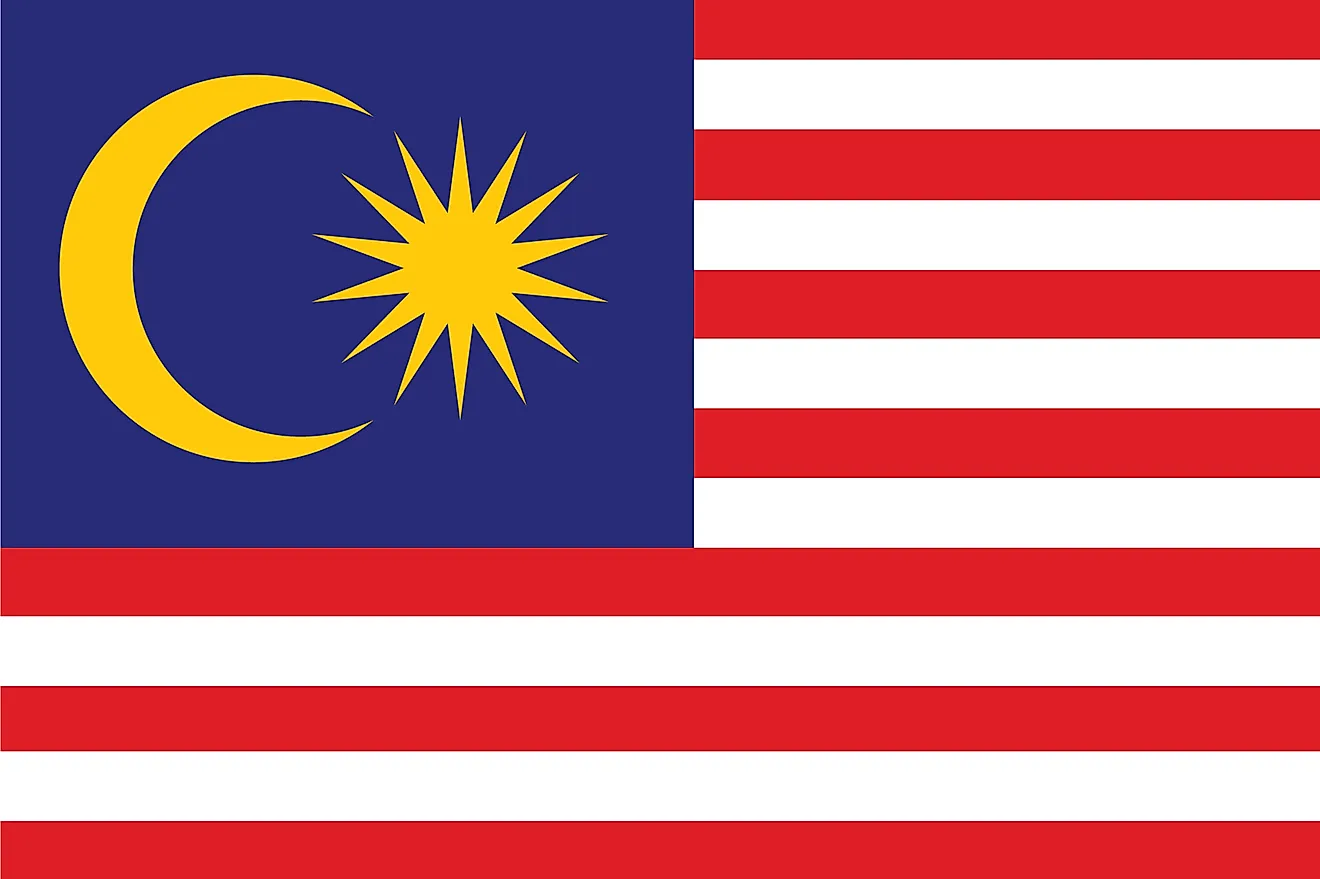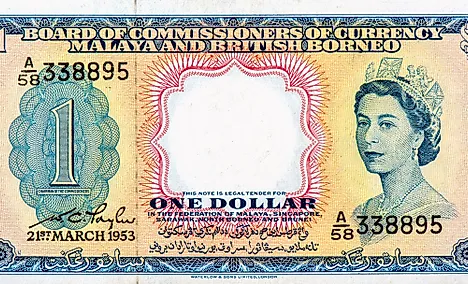What Does the Blue Part of the Malaysia Flag Represent
Flags, Symbols, & Currencies of Malaysia

The current flag of Malaysia was adopted on September 16, 1963. It resembles the flag of the US, featuring fourteen horizontal stripes of alternating red and white colors. The canton of the flag has a blue field and features a crescent and a star that are yellow in color. The star has fourteen points. The flag is often referred to as Jalur Gemilang (Stripes of Glory). The version of the flag, adopted in 1950, featured 11 red and white stripes. The national flag has a height to length proportion of 1:2.
The red, white, and blue colors used in the Malaysian flag indicate that the country belongs to the Commonwealth. The star and the crescent symbolize Islam, the country's official religion. The yellow color is a reminder that the Malay Rulers are independent of foreign control. The 14 stripes and 14 points on the star represent the equality of the country's 13 states and their unity with the federation.
History of the Flag of Malaysia
The national flag of Malaysia currently in use was first raised on September 16, 1963. A different flag was in use in the country earlier. When the Malayan Union was replaced by the Federation of Malaya, the newly formed government of the federation announced a contest to design a new flag to represent the federation in 1947. Many designs were submitted and finally, the one designed by an architect named Mohamed Hamzah was chosen. The selected design had 11 alternating bands of blue and white and a canton with a red field featuring a yellow five-pointed star and crescent. This design was then modified by switching the stripe and canton colors. The five-pointed star was modified with the addition of six more points. The flag was then adopted on May 19, 1950, by King George VI. It was first officially raised on August 31, 1957, when the Federation became independent of British rule. It was hoisted in place of the British Union Flag. After Malaysia was born in 1963, the flag's design was tweaked slightly to represent the new states in the federation. Three more stripes were added and the star now had 14 points to symbolize the three newly added states. The number did not change even after Singapore was expelled from the federation and three new territories were later added. The 14th stripe and point today represents the federal government in general.
Symbols of Malaysia
National Coat of Arms of Malaysia
The coat of arms of Malaysia, adopted in 1965, consists of four components; crest or helm, escutcheos, supporters, and motto. It features two tigers supporting a shield. The shield is topped by a yellow crescent and 14-point star (representing Islam and Mornachy). The escutcheos (shield) represents the state under the Malaysian federation. The upper portion of the shield consists of red background with five krises (representing unfederated Malay state). Below the shield is the national motto, "Bersekutu Bertambah Mutu" (Unity is Strength) on the ribbon.
National Anthem
- Anthem Title: Negaraku (My Country)
- Music composer: Pierre-Jean de Béranger
- Lyricist: Saiful Bahri
- Date of Adoption: 1957
The national anthem of Malaysia, Negaraku (My Country), was adopted at independence in 1957. The anthem's tune was originally the anthem of the region of Perak, adopted from "La Rosalie" (French melody composed by Pierre-Jean de Béranger). At independence, all the 11 states that made the Malaysian Federation had individual anthems. A committee was set to choose a suitable national anthem for Malaysia. A worldwide competition was held, attracting 514 entries. However, none of the entries was considered suitable. The committee also inviited international composers but their entries were also all turned down. Finally, the committee settled on the Perak State Anthem because of its "traditional flavor."
Negaraku
Negaraku,
Tanah tumpahnya darahku,
Rakyat hidup,
Bersatu dan maju!
Rahmat bahagia,
Tuhan kurniakan,
Raja kita,
Selamat bertakhta!
Rahmat bahagia,
Tuhan kurniakan,
Raja kita,
Selamat bertakhta!
My Country
My motherland,
For whom I spill my blood,
The people live,
United and progressive!
With divine blessings
of peace and joy,
Long may our King,
reign sublime!
With divine blessings
of peace and joy,
Long may our King,
reign sublime!
The Currency of Malaysia is the Malaysian ringgit
The currency used in Malaysia is the Malaysian ringgit, formerly known as the Malaysian dollar. It is symbolized as RM and coded as MYR. Bank Negara Malaysia is the only institution allowed to issue the Malaysian ringgit.
Coinage
The coinage of the Malaysian Ringgit took place in three series. The first series took place in 1967 and saw the introduction of coins in denominations of 1, 5, 10, 20 and 50 sen. The 1 ringgit coin was introduced and circulated four years later. The coins produced were made of cupronickel and contained the federal star found on the national flag of Malaysia and the then Malaysian Houses of Parliament. The second series of coins were designed by Low Yee Kheng and released in 1989. They had totally different designs from the coins produced earlier and were made of an alloy of copper, zinc, and tin. These coins had items that represented the Malaysian culture as opposed to those made in the first phase. Most of the coins produced in these two series are no longer in circulation. The third series of coins were minted at the Bank Negara Mint and supplied by the Poogsan Corporation of South Korea as a directive by the Deputy Finance Minister, Datuk Donald in 2011. The denominations of the coins currently used are 5, 10, 20, and 50 sen.
Bank Notes
The notes in Malaysia were issued in four series. In the first series, which was in 1967, denominations of 1, 5, 10, 50, 100, and 1000 dollars were issued. Many years later in 1993, the second series involved the replacement of the $1 note by a coin. In 1999, the RM 500 and RM 1000 were discontinued. In the third series, the designs of the notes printed were in tandem with the vision of Malaysia to be a self-sufficient industrialized state by year 2020. These are the notes which are currently being used which are denominated as RM1, RM5, RM10, RM20, RM50, and RM100.
Commemorative Bank Notes
RM 50 is the only note that stands out as it was issued to commemorate the Commonwealth Games held in Malaysia in 1998.
History of Currencies of Malaysia
On June 12th, 1967 the Bank Negara Malaysia issued the Malaysian dollar for public use. This currency replaced the British Borneo and Malaya dollar at par value. The new Malaysian dollar was valued at 8.5 dollars against the Sterling Pound but five months later the pound was devalued by 14.3 percent eventually leading to its collapse in 1972. In 1993, the sign RM replaced the dollar sign '$'. Between 1997 and 2005, the ringgit experienced devaluation due to the "1997 East Asian financial crisis." Subsequently, the Central Bank resolved to pegging ringgit to the US currency and making it non-tradeable out of the nation of Malaysia. Following these monetary measures, the ringgit appreciated incredibly against the dollar to 3.16 in April 2008.
Source: https://www.worldatlas.com/flags/malaysia

Belum ada Komentar untuk "What Does the Blue Part of the Malaysia Flag Represent"
Posting Komentar